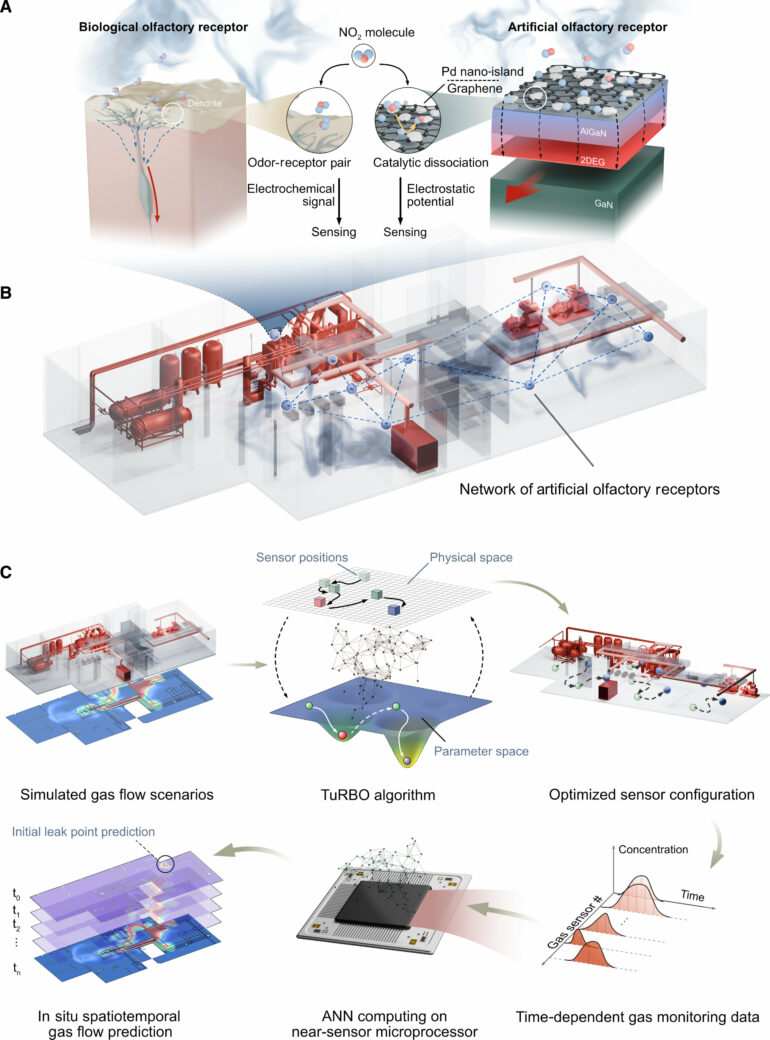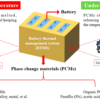Researchers at the University of Virginia School of Engineering and Applied Science developed an AI-powered system that mimics the human sense of smell to detect and track toxic gases in real time. Using advanced artificial neural networks combined with a network of sensors, the system quickly identifies the source of harmful gases like nitrogen dioxide (NO₂) that poses severe respiratory health risks.
According to the World Health Organization, outdoor air pollution, including NO₂, contributes to approximately 4.2 million premature deaths globally each year, primarily due to respiratory conditions like asthma and chronic obstructive pulmonary disease (COPD).
Their article, titled “Network of Artificial Olfactory Receptors for Spatiotemporal Monitoring of Toxic Gas,” is published in Science Advances.
Graphene-based sensors mimic human smell
The innovative system relies on nano-islands of metal catalysts embedded on graphene surfaces. This device functions like an artificial nose, reacting with targeted toxic gas molecules. As nitrogen dioxide molecules bind to the graphene, the conductivity of the sensor changes, allowing the system to detect gas leaks with extreme sensitivity.
“Nano-islands of metal catalysts are tiny clusters of metal particles deposited on a surface, such as graphene, that enhance chemical reactions by increasing the surface area for gas molecules to interact, enabling precise detection of toxic gases,” said Yongmin Baek, a research scientist in the Department of Electrical and Computer Engineering who is leading the R&D for the sensors.
Kyusang Lee, associate professor of electrical and computer engineering and materials science engineering, and one of the lead researchers on the project, explains, “By integrating AI with state-of-the-art gas sensors, we’re able to pinpoint gas leaks with unprecedented accuracy, even in large or complex environments. The artificial olfactory receptors are able to detect tiny changes in gas concentrations and communicate that data to a near-sensor computing system, which uses machine learning algorithms to predict the source of the leak.”
Neural net optimizes sensor placement
The system’s artificial neural network analyzes data from the sensors in real-time, based on the optimized sensor placement to ensure coverage and efficiency of the system. This optimization is enabled by a “trust-region Bayesian optimization algorithm,” a machine learning technique that breaks down complex problems into smaller regions to find the most efficient sensor positions. This ensures fewer resources are used while providing faster and more accurate gas leak detection.
Electrical and computer engineering Ph.D. student Byungjoon Bae adds, “Our AI-powered system has the potential to make industrial settings, urban areas and even residential buildings safer by constantly monitoring air quality. It’s a major step forward in preventing long-term health risks and protecting the environment.”
The research team includes Yongmin Baek, Byungjoon Bae, Jeongyong Yang, Wonjun Cho, Inbo Sim, Geonwook Yoo, Seokhyun Chung, Junseok Heo, and Kyusang Lee, who collaborated across institutions such as the University of Virginia and Ajou University.
More information:
Yongmin Baek et al, Network of artificial olfactory receptors for spatiotemporal monitoring of toxic gas, Science Advances (2024). DOI: 10.1126/sciadv.adr2659
Provided by
University of Virginia
Citation:
AI-powered system detects toxic gases with speed and precision (2024, November 5)



